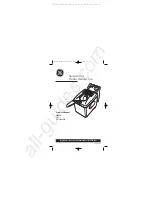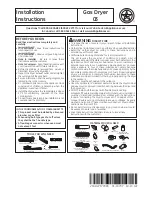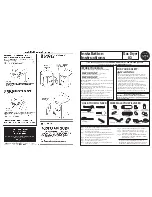
•
Liquid
•
Solid
•
No
melt
L = 16 on, 18 off.
S = 8 on, 26 off (default for gas).
0 = 100% on.
On solid state control only, "CY" (cycle) is displayed
before the shortening letter designation, and zero
represents none (no melt).
The control then resumes normal operation as
described in this sequence.
1.
Conditions.
A.
Fryer connected to correct supply voltage
and properly grounded.
B.
Gas supply and gas combination valves are
on.
C.
Power switch to the fryer section in the off
position.
D.
Shortening at proper level in fry tank, and
below last set point temperature used.
E.
Cooking control is set up properly and ready
to use.
F.
Manual drain valve closed (drain valve
interlock switch N.O. is closed).
G. High limit thermostat closed.
2.
Turn on power switch.
A.
Power to terminal 5 (COM) on left and right
basket relays.
B.
24VAC transformer energized.
3.
Cooking control powers on, initializes and
performs a diagnostic self check.
NOTE:
If cooking control passes diagnostic self
check, the output signals are turned on and operation
sequence continues. If cooking control does not pass
diagnostic self check, the control displays an error
message for the problem, disables keypad, and
sounds the electronic alarm continuously. Refer to
TROUBLESHOOTING.
4.
Ignition module is powered (24VAC), initializes,
and generates spark at ignitor (ignition trial cycle
starts).
A.
Pilot voltage (PV) N.O. contacts close, pilot
valve coil energized at P3 terminal, and
valve opens for gas flow to pilot.
1)
Pilot flame established. A micro amp
flame sense
current is rectified to
ignition module through ignitor cable
and sparking stops.
2)
Main voltage (MV) N.O. contacts close
and provide ignition status input signal
(24VAC) to cooking control at pin E1-6
B.
If pilot ignition is not established within the
first several seconds of ignition trial time, the
cooking control display indicates
pilot out
as
the ignition module continues to generate a
spark at ignitor.
C.
If pilot is not established within 90 seconds
of the ignition module being energized, the
ignition module locks out power to gas
valve. Cooking control display indicates
ignition lockout
, keypad is disabled, and the
electronic alarm sounds continuously.
1)
The system remains locked out until
the power switch is cycled to reset the
system and restart the ignition trial
cycle.
5.
Cooking control evaluates input signals from:
ignition status at pin E1-6; drain valve interlock at
pin E1-5; and temperature probe at pins E1-3 and
E1-4 (high and low).
A.
If the inputs to the control are valid and the
shortening temperature is below set point,
the heat output (24VAC) at pin E1-8 is then
activated and power is applied to heat
control Triac. Display indicates the selected
melt cycle if shortening temperature is
below 135°F; or display indicates heating if
shortening temperature is above 135°F.
B.
Heat control Triac energized and supplies
voltage to gas valve M1 terminal.
1)
Main valve coil energized, and valve
opens for gas flow to burners.
2)
Burners light and heat the shortening
in fry tank.
NOTE:
As long as the ignition control module senses
a pilot flame, the internal main voltage (MV) contacts
(N.O.) on the ignition module remain closed, and main
gas valve stays on.
6.
Shortening reaches set temperature.
A.
Cooking control deactivates the heat output
(24VAC) at pin E1-8, and power is removed
from heat control Triac.
1)
Main valve coil de-energized, and
valve closes.
2)
Gas flow stops and burners go out.
GR Series Gas Fryers with NCC Controls (formerly Tridelta / Built after 3/05) - ELECTRICAL OPERATION
Page 39 of
56
F35660
Rev. A (0717)
















































